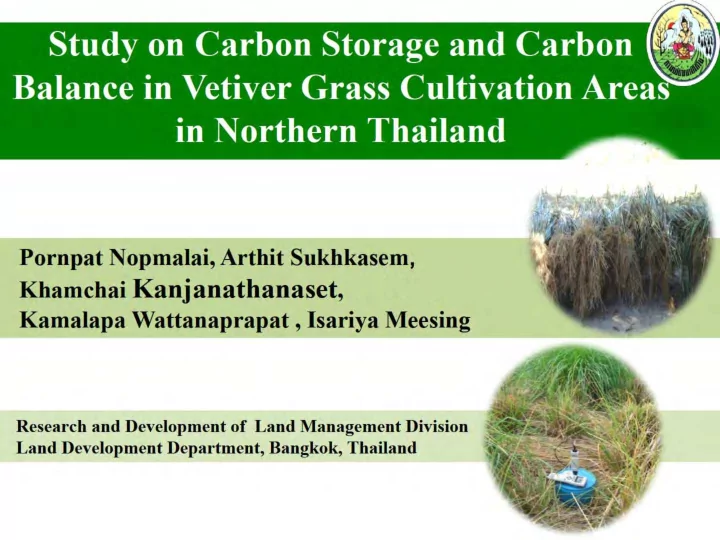

Soil characteristic - Nong Mot soil - Soil was classified as fine, kaolinitic, isohyperthermic Typic Kandiustults (Soil Survey Staff, 2006) - loamy or loamy clay soil texture - dark brown to very dark gray brown - pH 5.0-6.0
Step to study • Preparation of the experimental plots & young vetiver plants • vetiver grasses were planted on June 2008- July 2010 for 2 years • Plot size 4x6 m with planting spacing 50x50 cm • Leaves were cut and mulched in each plot 5 times, when 8, 12, 16, 20 and 24 months after planting
Soil sampling & analysis - Sampling of disturbed soil 3 level;0-15, 15-30, 30-50 cm depth to determine soil pH, soil organic carbon, available phosphorus & exchangeable potassium
- Sampling of undisturbed soil 3 level; 0-15, 15-30, 30-50 cm depth by core method to determine soil bulk density and soil moisture
Gas Sampling Setting up a static closed chamber in all plots PVC chamber with cover has an inner diameter 20 cm & height 25 cm. Its base was installed, inserted into the soil Measuring CO 2 from soil surface every month by using a Hand-Held CO 2 Meter (model GM70) Temperature in chamber , soil, air around chamber were also measured by a thermometer Soil samples were collected to determine soil moisture
Calculation of Carbon Content in Vetiver Grass and Soil Vetiver grass C vetiver = C leaf + C root C leaf = % OC leaf x M leaf C root = % OC root x M root C vetiver = total carbon content (t ha -1 ) C leaf , C root = total carbon content in leaf and root (t ha -1 ) % OC leaf , % OC root = percentage of organic carbon in leaf and root (%) M leaf , M root = biomass of leaf and root (t ha -1 )
Soil sample C soil = C 0-15 + C 15-30 + C 30-50 C 0-15 = % OC 0-15 x D 0-15 x V 0-15 C 15-30 = % OC 15-30 x D 15-30 x V 15-30 C 30-50 = % OC 30-50 x D 30-50 x V 30-50 C soil = soil carbon stock of 3 soil layers 0-15, 15-30,30-50 cm (t ha -1 ) C 0-15 , C 15-30, C 30-50 = soil carbon content in 0-15, 15-30, 30-50 cm (t ha -1 ) % OC 0-15, % OC 15-30, % OC 30-50 = percentage of organic carbon in 0-15, 15-30, 30-50 cm (%) D 0-15 , D 15-30, D 30-50 = soil bulk density in 0-15, 15-30, 30-50 cm (g cm -3 ) V 0-15 , V 15-30, V 30-50 = soil volume of each layers (m 3 m -2 ).
CO 2 Emission Rate (F) Calculation (Hutchinson and Mosier,1981) Ci = qiMP RT Ci = mass / volume concentration (mg CO 2 m -3 ) qi = volume / volume concentration (m 3 m -3 ) M = molecular weight of CO 2 (44 g mol -1 ) P = atmospheric pressure (1 atm) R = gas constant (8.2058x10 -5 m 3 .atmK -1 mol -1 ) T = average temperature inside the chamber (K). F = V Ci A t F = emission rate (mg CO 2 m -2 h -1 ) V = volume of chamber (m 3 ) A = surface area of the chamber (m 2 ) Ci = the increase of CO 2 concentration in the chamber t as the function of time (mg m -3 hr -1 )
8. CO 2 emission rate (mg C m -2 h -1 ) from soil surface - Planting vetiver grass increased CO 2 emission comparing to the control - Surat Thani produced the highest amount of CO 2 accumulation 6,518 mg C m -2 h -1 - Non-vetiver grass plot produced the lowest CO 2 accumulation 3,496 mg C m -2 h -1
9. Soil carbon balance ( kg C m -2 y -1 ) in non-vetiver grass and vetiver grass cultivation areas C balance = (C soil +C root +C leaf(1) ) - (C leaf(2) +C released soil ) C balance = soil carbon balance in each ecotype C soil = carbon content in soil C root = carbon content in root C leaf(1) = carbon content of leaf accumulated in soil C leaf(2 ) = carbon content of leaf released as CO 2 C released soil = carbon content in soil released as CO 2
9. Soil carbon balance ( kg C m -2 y -1 ) in non-vetiver grass and vetiver grass cultivation areas (continued) - Non-vetiver grass cultivation system caused soil carbon loss 0.31 kgC m -2 y -1 . - Vetiver grass cultivation areas increased soil carbon storage 1.37- 1.53 kgC m -2 y -1 . - C.zizanioides cultivation areas raised carbon storage higher than C.nemoralis.
Conclusion Vetiver grass cultivation areas with mulching of cut leaves comparing to non- vetiver grass cultivation areas increased soil carbon storage and CO 2 emission from soil surface. Vetiver grass cultivation increased soil carbon storage. Non- vetiver grass cultivation areas resulted in loss of soil carbon storage. The agricultural cropping system with vetiver grass cultivation helps to increase soil carbon storage and improve soil chemical and physical properties. Uses of vetiver grass is a simple and cheap technology. Farmers can practice by themselves easily. Therefore, it is a sufficient and sustainable farming for development of the communities and nationwide.
Recommend
More recommend